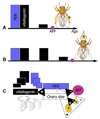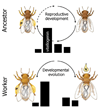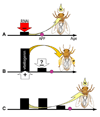The developmental genetics and physiology of honeybee societies
- PMID: 20514137
- PMCID: PMC2875690
- DOI: 10.1016/j.anbehav.2010.02.007
The developmental genetics and physiology of honeybee societies
Abstract
Eusocial animal societies, as diverse as those found in the ants, bees, wasps, shrimp and naked mole-rats, are structured around one or few reproductive females. The remaining females are helpers called 'workers' that are mostly sterile. A paradigm in studies of eusociality is that worker sterility is a key to societal functions because advanced sociality cannot be achieved when there is conflict over reproduction. Yet, traits such as sensory responsiveness, foraging and hoarding behaviour that change between female reproductive life stages also vary between workers. This variation is central to worker division of labour, a complex social trait believed to be instrumental for the ecological success of animal societies. Thus, we took a step back from established views on worker sterility and societal functions, and hypothesized that division of labour can be better understood if adaptive variation in worker behaviour is seen as emerging from pre-existing mechanisms associated with female reproduction. In exploring this reproductive ground plan hypothesis (RGPH) in honeybee workers, we established that variation in foraging division of labour correlates with ovary size and is affected by expression changes in vitellogenin, an egg yolk protein precursor. Here, we explain and reconcile the RGPH with data on honeybee sensory sensitivity, genomic mapping, transcript and endocrine profiling, and link our discussion with Ihle et al. (2010, this issue, pp. xx-xx). The findings bring together mechanistic and evolutionary explanations of honeybee worker behaviour. This essay suggests that a broader view on worker reproductive traits can increase the understanding of animal social behaviour.
Figures




References
-
- Amdam GV, Omholt SW. The hive bee to forager transition in honeybee colonies: the double repressor hypothesis. Journal of Theoretical Biology. 2003;223:451–464. - PubMed
-
- Amdam GV, Page RE. Oldroyd and Beekman do not test ground plan hypothesis that explains origins of social behavior. PLoS Biology. 2008;6 e56r2248.
-
- Amdam GV, Hartfelder K, Norberg K, Hagen A, Omholt SW. Altered physiology in worker honey bees (Hymenoptera: Apidae) infested by the mite Varroa destructor (Acari: Varroidae): a factor in colony loss during over-wintering? Journal of Economic Entomology. 2004a;97:741–747. - PubMed
Grants and funding
LinkOut - more resources
Full Text Sources
Miscellaneous
